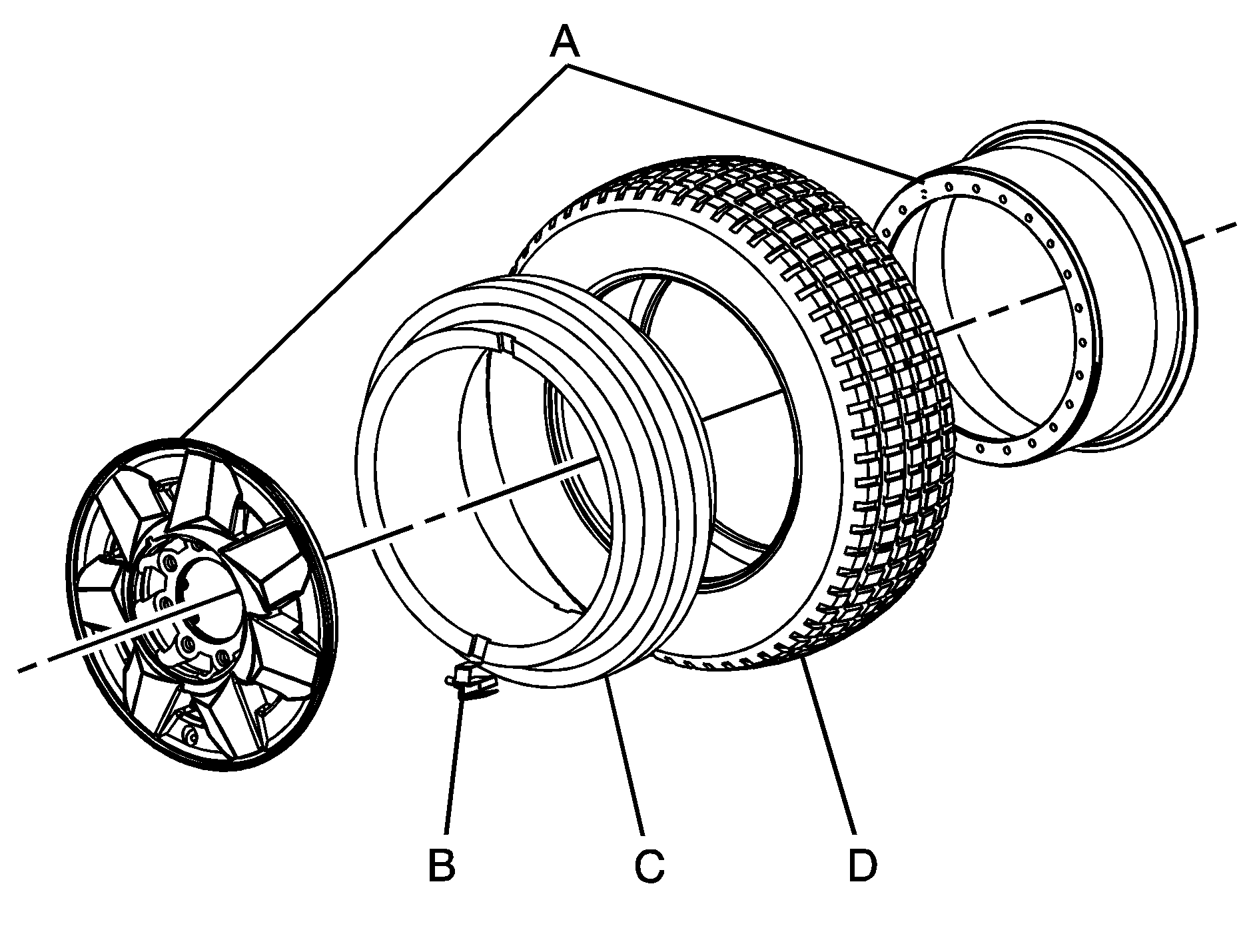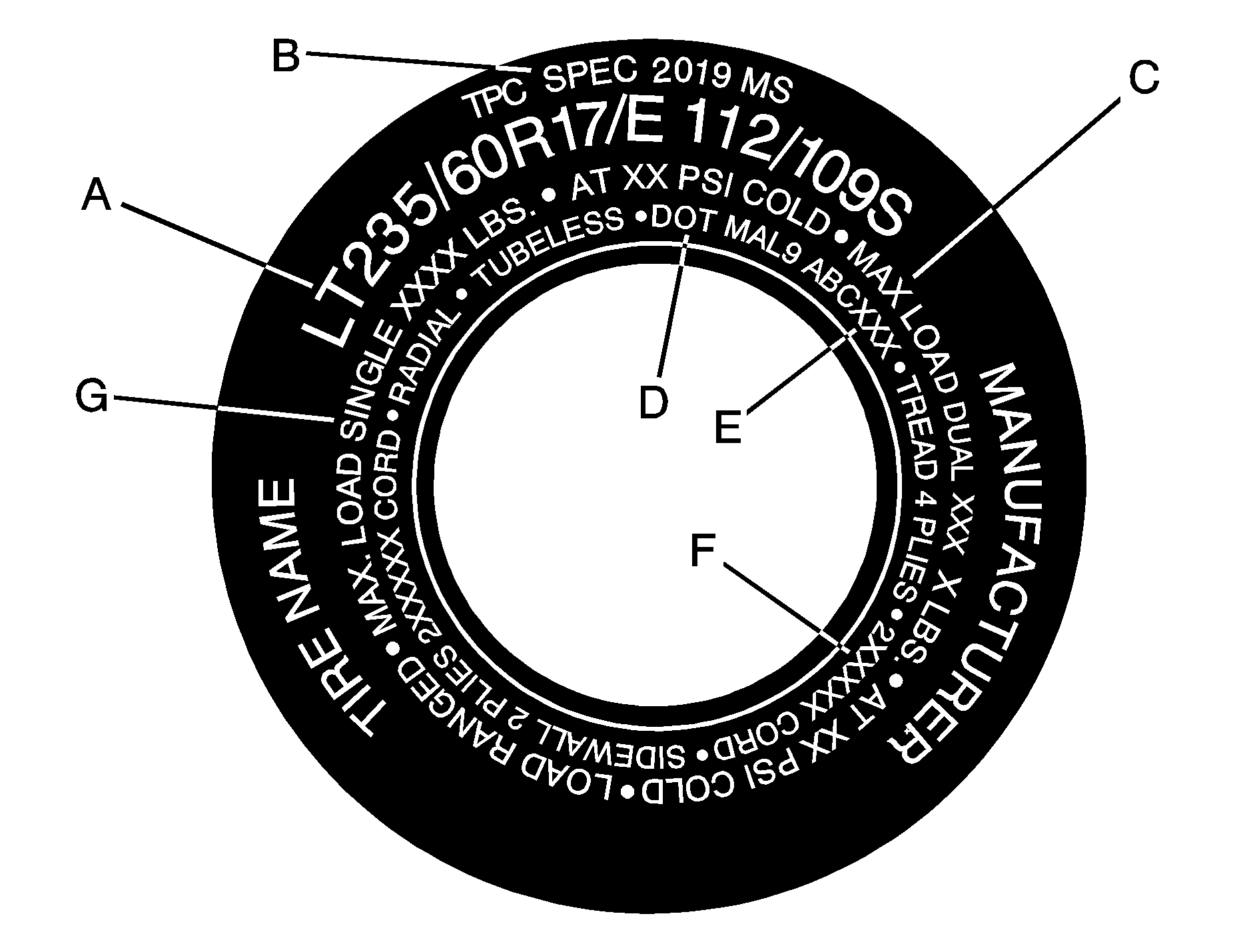Your new DeVille Protection Series vehicle comes with a tire and wheel assembly equipped with the enhanced mobility system. Servicing the enhanced mobility tire and wheel assembly requires techniques and tools that are unique to its design. See your GM dealer, preferably your delivering dealer, if any tire and wheel service work is needed.
Caution: Poorly maintained
and improperly used tires are dangerous.
• Overloading your tires can cause overheating as a result of too much friction.
You could have an air-out and a serious accident. See "Loading Your Vehicle"
in the Index of your vehicle owner manual. • Underinflated tires pose the same danger as overloaded tires. The resulting
accident could cause serious injury. Check all tires frequently to maintain the recommended
pressure. Tire pressure should be checked when your tires are cold. • Overinflated tires are more likely to be cut, punctured or broken by a
sudden impact -- such as when you hit a pothole. Keep tires at the recommended
pressure. • Worn, old tires can cause accidents. If your tread is badly worn, or if
your tires have been damaged, replace them.
Enhanced Mobility System
The tire and wheel assembly on your new vehicle includes the enhanced mobility system. The system is designed to provide vehicle mobility even if all four tires have been deflated.

Each enhanced mobility tire and wheel assembly, excluding the spare tire and wheel, has a two-piece wheel (A), a tire pressure monitor (B), a reinforced rubber insert (C), and a light truck tire (D).
Standard light truck tires are fitted with a solid rubber insert and mounted onto a two-piece, forged aluminum wheel. The insert is placed inside the tire cavity and fitted to the center of the wheel. The insert keeps the tire bead pressed firmly against the wheel rim and prevents the tire from being pinched flat against the wheel rim when the tire has lost air pressure.
A Tire Pressure Monitor (TPM) is used to monitor air pressure inside each enhanced mobility tire. When the TPM system detects a low tire pressure condition, a message is displayed on the Driver Information Center (DIC). For additional information on the TPM system, see Tire Pressure Monitor System .
Caution: If your vehicle has a flat tire or the CHECK TIRE PRESSURE message is displayed on the Driver Information Center, your vehicle's handling will be reduced during severe maneuvers. If you drive too fast, you could lose control of your vehicle. You or others could be injured. Do not drive over 50 mph (80 km/h) if your vehicle has a flat tire or if the CHECK TIRE PRESSURE message is displayed. Drive cautiously, and check your tire pressures as soon as you can.
The enhanced mobility tire and wheel assembly is designed to provide vehicle mobility for 30 miles (48 km) at 30 mph (48 km/h), with a flat tire condition. The distance you can drive with a flat tire decreases as vehicle speed increases. Driving with a flat tire beyond the 30 mile limitation may cause damage to the insert, tire and wheel.
Your vehicle has a full-size spare tire stored in the trunk. This spare does not have the enhanced mobility features. After installing the spare tire on your vehicle you should stop as soon as you can and make sure the spare tire is correctly inflated. Have the damaged or flat enhanced mobility tire repaired or replaced as soon as you can and installed back onto your vehicle. This way, a spare tire will be available in case you need it again. You can operate your vehicle for long periods with the spare tire and wheel installed, however SERVICE TIRE MONITOR will be shown on the driver information center display when the spare tire is installed. This message should go off once you re-install an enhanced mobility tire and wheel containing a TPM sensor.
Caution: Enhanced mobility tires and wheels are constructed differently than standard tire and wheel assemblies and could explode during improper service. You or others could be injured or killed if you attempt to repair, replace, disassemble or reassemble an enhanced mobility tire and wheel assembly. Let only an authorized service center repair, replace, disassemble or reassemble enhanced mobility tires and wheels.
Servicing the enhanced mobility tire and wheel assembly requires special techniques and tools that are unique to its design. DeVille Protection Series delivery dealers are specifically trained and equipped to service the enhanced mobility tires and wheels. To locate the nearest DeVille Protection Series dealer, call Roadside Assistance. For phone numbers and Roadside Assistance details, see "Customer Assistance Information" in the Index of the DeVille owner's manual.
Some road hazards can damage a tire and wheel beyond repair. This damage could occur even before you've driven on the tire in a deflated condition. If an enhanced mobility tire or wheel has been damaged, check with an authorized DeVille Protection Series dealer to determine if the tire can be repaired or should be replaced. To maintain your vehicle's enhanced mobility feature, all replacement parts must be enhanced mobility system parts.
Tire Sidewall Labelling
Useful information about a tire is molded into the sidewall. The following illustration shows an example of a light truck tire sidewall.

(A) Tire Size: The tire size code is a combination of letters and numbers used to define a particular tire's width, height, aspect ratio, construction type and service description. See the "Tire Size" illustration later in this section for more detail.
(B) TPC Spec (Tire Performance Criteria Specification): Original equipment tires designed to GM's specific tire performance criteria have a TPC specification code molded onto the sidewall. GM's TPC specifications meet or exceed all federal safety guidelines.
(C) Dual Tire Maximum Load: Maximum load that can be carried and the maximum pressure needed to support that load when used in a dual configuration.
(D) DOT (Department of Transportation): The DOT code indicates that the tire is in compliance with the U.S. Department of Transportation Motor Vehicle Safety Standards.
(E) Tire Identification Number (TIN): The letters and numbers following DOT code are the Tire Identification Number (TIN). The TIN shows the manufacturer and plant code, tire size, and date the tire was manufactured. The TIN is molded onto both sides of the tire, although only one side may have the date of manufacture.
(F) Tire Ply Material: The type of cord and number of plies in the sidewall and under the tread.
(G) Single Tire Maximum Load: Maximum load that can be carried and the maximum pressure needed to support that load when used as a single. For information on recommended tire pressure see Inflation - Tire Pressure .
Tire Size
The following illustration shows an example of a light truck tire size.

(A) Light Truck (LT-Metric) Tire: The United States version of a metric tire sizing system. The letter "LT" as the first two characters in the tire size means a light truck tire engineered to standards set by the U. S. Tire and Rim Association.
(B) Tire Width: The three-digit number indicates the tire section width in millimeters from sidewall to sidewall.
(C) Aspect Ratio: A two-digit number that indicates the tire height-to-width measurements. For example, if the tire size aspect ratio is 60, as shown in item C, of the illustration, it would mean that the tire's sidewall is 60 percent as high as it is wide.
(D) Construction Code: A letter code is used to indicate the type of ply construction in the tire. The letter R means radial ply construction; the letter D means diagonal or bias ply construction; and the letter B means belted-bias ply construction.
(E) Rim Diameter: Diameter of the wheel in inches.
(F) Service Description: The service description indicates the load range and speed rating of a tire. The load index can range from 1 to 279. Speed ratings range from A to Z.
Your new vehicle comes with high-quality tires made by a leading tire manufacturer. If you ever have questions about your tire warranty and where to obtain service, see your GM Warranty booklet for details. For additional information refer to the tire manufacturer's booklet included with your vehicle.
Caution:
• Poorly maintained and improperly used tires are dangerous. • Overloading your tires can cause overheating as a result of too much
friction. You could have an air-out and a serious accident. See
Loading the Vehicle
. • Underinflated tires pose the same danger as overloaded tires. The resulting
accident could cause serious injury. Check all tires frequently to maintain the
recommended pressure. Tire pressure should be checked when your tires are cold. • Overinflated tires are more likely to be cut, punctured, or broken by
a sudden impact -- such as when you hit a pothole. Keep tires at the recommended
pressure. • Worn, old tires can cause accidents. If your tread is badly worn, or
if your tires have been damaged, replace them.
